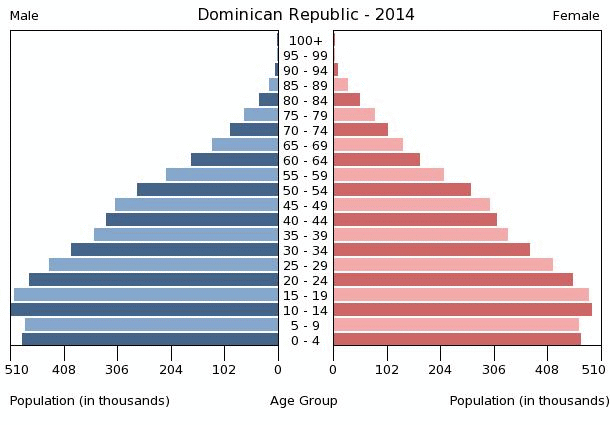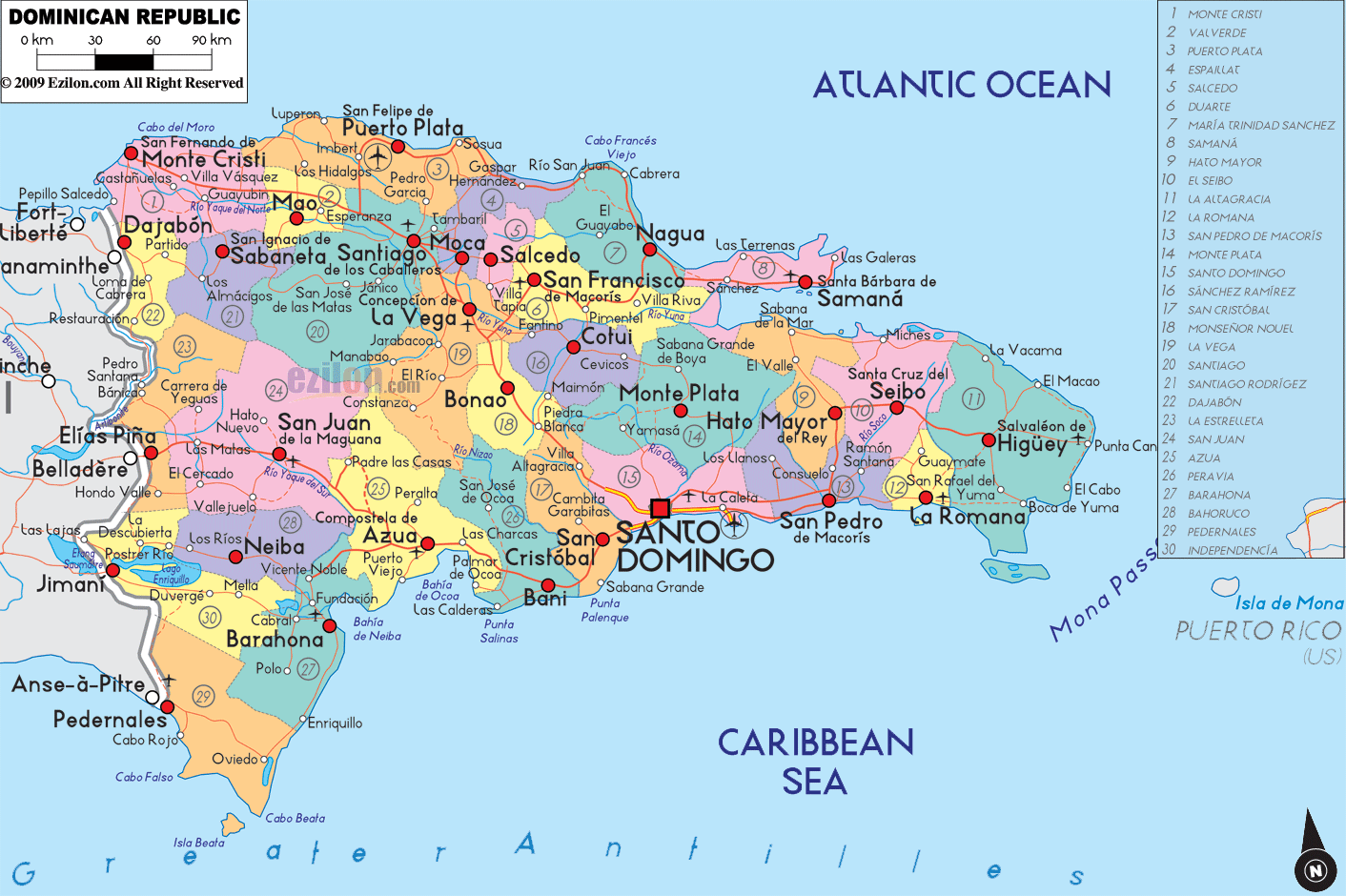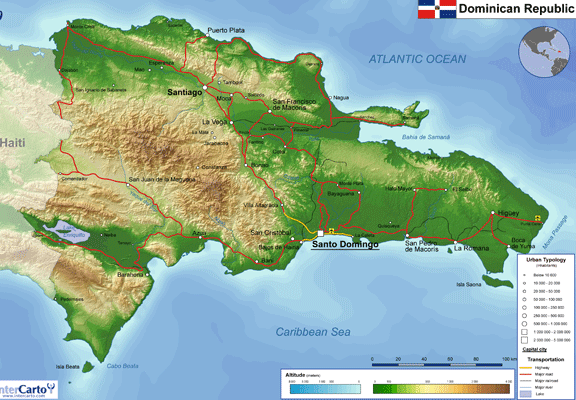
Country Demographics
Dominican Republic
The blue color in the flag represents liberty, red is the blood of heroes, and white represents salvation.
In the middle of the flag is a coat of arms.
Geographic Coordinates- 19.0000 degrees N,70.6667 degrees W. The geographic coordinates of the Dominican Republic can contribute to temperature and climate. This is because common choices for geographic coordinates ar longitudes, latitudes and elevations.
Official Language- Spanish (Dominican Spanish). This language came to be in the Dominican Republic when spanish explorers came to the island.
Minority Languages- Haitian Creole, Southwestern Creole, Samaná English and Chinese. Haitian Creole as well as southwestern Creole is spoken in Haiti, the neighboring country of the Dominican Republic. Immigrants from Haiti in the Dominican Republic speak this language. Samaná english is a form of the english language spoken by black immigrants that once lived in the Dominican Republic. Chinese immigrants migrated to the Dominican Republic during the Chinese Revolution, hence bringing their native tongue with them.
Political Map-
Physical Map-
Life Expectancy- 73.23 years. Whether this age is considered young or old, the life expectantcy of the people in this country relies on medical care provided, whether the environment has health risks or not, if the industry has an effect on human health and medical education provided. The Dominican Republic has stable medical care and education, while the industrialized areas of the country do have health risks.
Timeline-
(1492) Christopher Columbus visits the island, which he names Hispaniola, or "Little Spain". This was the cause of exploration of the island itself. The effect of this was the Dominican Republic and Haiti being colonized and explored in the first place.
(1496) Spaniards set up first Spanish colony in Western hemisphere at Santo Domingo, which subsequently serves as capital of all Spanish colonies in America. (Colonization first takes place at this time, this is the effect).
(1697) Treaty of Ryswick gives western part of Hispaniola island (Haiti) to France and eastern part (Santo Domingo - the present Dominican Republic) to Spain. The effect of this treaty was peace for some time.
(1795) Spain ceded its portion of Hispaniola Island to France. This action lead to even more peace between Spain and France, which was quite beneficial at the time.
(1808) Following revolt by Spanish Creoles, Spain retook Santo Domingo. This was the cause of a huge conflict between Spain and France.
(1810) Napoleon overthrew King of Spain. The cause of this was Spain reclaiming Santo Domingo. The effect of this act was beneficial, as the Haitian Republic was born.
(1822) Haitian Republic born. The cause of this was because the US owed the Dominicans something. The effect was that the Haitians could have their own area to live.
(1844) Dominican Republic gained independence from Haiti, Santo Domingo declared independence, became Dominican Republic. The cause of this was the previous point. The effect was very beneficial. Now that the Dominican Republicans were independent, economy improved, there was less poverty and the population decreased.
Birth Rate- 18.73 births/ 1000. High birth rates result in an increase in population. Low birth rates result in a decrease or stunt in population.
Death Rate- 4.55 deaths/ 1000. Death is reflected on how death is handled in the country. Death rate is the result of either good or bad living conditions and medical care provided. A high death rate would result in a decrease in population and a low death rate would result in little decrease in population.
Infant Mortality Rate- 18.84 deaths/ 1000 live births. Infant mortality is the result of poor medical care provided in the country. By looking at the infant mortality rate, one can tell about the health care/ medical care provided in the country. Judging from a low infant mortality rate, one can conclude that the country is well off medically and has stable conditions in which children are born. If a country has a high infant mortality rate, then, one can conclude that the country does not have stable living/birthing conditions for a newly born healthy or ill infant. A high infant mortality rate can lead to a decrease in population.
Total Fertility Rate- 2.33 children born/ 1000 women. Total fertility rate of women in the Dominican Republic reflects on women's status. For example, if women are educated and occupied in a profession, then they would not have the time to raise a child. If a women are unemployed and at home,essentially unoccupied, then they will have the time to raise a child and give birth to more than one child. So, the total fertility rate of women in the Dominican Republic, technically, also relates to gender roles and the idea of machismo, where men are seen as more masculine (in some cases) if the gender role is strictly enforced in the household/family, hence leading to women staying in the home and birthing more children than a woman recieving a proper education and employment oppurtunities. An increase in total fertility rate would result in an increase in population.
Rate of Natural Increase- 14.18. The rate of natural increase is very important because when looking at it, one can determine what stage of the Demographic Transition Model, the country is in. In addition, to calculate the Rate of Natural Increase, one would have to subtract the death rate from the crude birth rate. In this way, the Rate of Natural Increase contributes to the population of a country. Also, by looking at the Dominican Republic's Rate of Natural Increase, I can tell that the country is in Stage 2 of the Demographic Transition Model.
Net Migration Rate- 1.91 migrants/ 1000 population. Net Migration Rate is the number of people moving into a country less than the number of people moving out of the same country. This number contributes to population, because the country that migrants are coming to, will definitely increase in population, if the Net Migration Rate is high. The population fluctuates as the Net Migration Rate does.
Stage of the Demographic Transition model- Stage 2. In a stage 2 country, there is a rapid decrease in the population's death rate as the birth rate still remains high. This is how the stage of the Dominican Republic on the Demographic Transition model, affects population.
Population Pyramid- The Population Pyramid above depicts a typical late Stage 2 country (on the Demographic Transition Model). One can tell because of the slightly triangular shape. In a stage 2 country, rapid decrease in the population's death rate occurs and the birth rate remains high. (The decrease in deaths represents improvements in overall health/medical care).
Climograph- Hot temperatures (Max.) are from 80 degrees to 87 degrees. Cold temperatures go from 69 degrees to 76 degrees. Winters: mild – Summers: are hot– The month with the highest temperature is August – The month with the lowest temperature is January. PRECIPITATION--Total Amount of Precipitation is 29 in. There is abundant precipitation. Months with abundant precipitation include May, June, September and October. Months with little precipitation (less than 2 in.) include January, February, March, July, and December.
Description of country’s climate (with climate types and temperature-altitudinal zone) – The Dominican Republic has a tropical (maritime) climate and during the winters it is dry. The rainy season extends from late April to October, occurring on the southern and eastern coasts. However, on the northern coast, rainfall is plentiful due to Tradewinds. August is the hottest month, and February and January are the coldest. The average temperature (annually), is 25 degrees Celsius, going from 18 degrees Celsius at the altitude of over 1,200 meters to 28 degrees Celsius at the altitude of 10 meters. Highs temperatures of 40 degrees Celsius are often seen in enclosed valleys, as well as lows of zero degrees Celsius in mountainous areas.
GDP- $63.97 billion. GDP is one of the most important numbers in economics. GDP is used to measure the true value of a country's economy.
HDI Ranking- 102 (2014) HDI measures education, income per capita, life expectancy etc. Basically, HDI ranking is the ranking of economies. Because HDI measures economy.
Level of Economic Development-The Dominican Republic's level of economic development is NIC. (Newly Industrialized Country). This means that the Dominican Republic is still in the process of industrialization.
Description of the country’s government type- The Dominican Republic has a Democratic Republican government type which is divided into three branches: The Executive branch, the Legislative branch and the Judicial branch. The Dominican government is controlled by an executive chief; a president that serves a four year term and is elected by the people, as stated in the newly ratified constitution. The Dominican Republic's legislative branch includes a bicameral national congress consisting of the Senate and the (lower house) Chamber of Deputies. In the Senate, there are 30 seats, each for one of the Republic's 30 provinces. Similar to the president, the associates of the Chamber of Deputies are elected by the citizens for a term of four years. The Judicial branch of the Dominican Republic is the National Judicial Council, which has the authority of nominating judges individually from others. In my eyes, a government type like this has no disadvantages.
Description of country’s economic system- The Dominican Republic's economy is the largest in the Carribean. The economy relies on agriculture, mining, trade and services. This economic system has it's disadvantages. Overworking employees, unfair salary and high taxes.
Description and pie chart of the country’s religious distribution-
As seen in the pie graph above, the Dominican Republic's religious distribution includes Catholics (57%) Protestants (23%) Unaffiliated (18%) Other (2%). Religious distribution affects economy because economy depends on (for example) the accessibility to specific animals and materials, or the ability to trade for the necessary animal products- all components that religion intertwines with.
Description of the women’s rights and treatment- 20% of women between the ages of 15 and 49 have experienced a form of physical violence in their lifetime. The treatment of women in the Dominican Republic is poor. As time has passed, development and growth has occurred throughout the country's age, but it seems as though women's rights have not been recognized or enforced. Violence against women has not only happened in the past, but the brutality is like never before. Cruelty has increased as well as legislature's inability to take action and stop the indemnity towards inevitably guilty offenders. The idea of female employment is not encouraged and women's images have (traditionally) forever been and are currently seen as nothing more than care providers, belonging nowhere other than in the home. Women are given most basic human rights, but the disregard towards the crime done to women
Description of push/pull factors and their effect on the net migration rate and factors affecting
urbanization if applicable- A major push factor of the Dominican Republic is poverty and debt. Poverty and debt are one down fall among many pulls of this country. An example of a pull factor of the Dominican Republic is it's close relationship with the US. Pull factors affect urbanization because the pull factors are their strongest in industrialized cities, hence leading to more people migrating there. When the pull factors are large in number, there could be more people entering the country than leaving because, more pull factors lead to a better quality of life/ living conditions. (For most).
Description of its diplomatic relations with the U.S.- The Dominican Republic's diplomatic relations with the US are great. The Dominican Republic is an important partner in hemispheric affairs due to it having the largest economy and second-largest country in terms of population and land mass in the Carribean. The Dominican Republic is closer in to the US in comparison to other countries in the Carribean. Both countries fight against drug trafficking and the Dominican Republic supports the US very much.
A description of energy consumption and production- Energy consumption in the Dominican Republic has grown extensively since the 1990's. The demand for electricity has reached an all time high. So much, that demand has constrained supply. Energy is not being supplied enough to satiate the prolonged demand for electricity.
A listing of natural resources (5-7) -The Dominican Republic is abundant with gold, silver, amber, larimar, ferronickel, bauxite, coal, tin, marble, salt, gypsum, and stone. Natural resources (as one whole; overall) are an immense component of any economy because they deal with supply and demand. Natural resources are exported out of the country. This builds economy. Natural resources are what some careers rely on. Careers are what help shape a strong economy. Natural Resources are the building blocks of economy.









